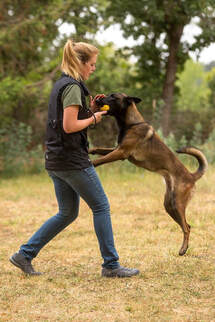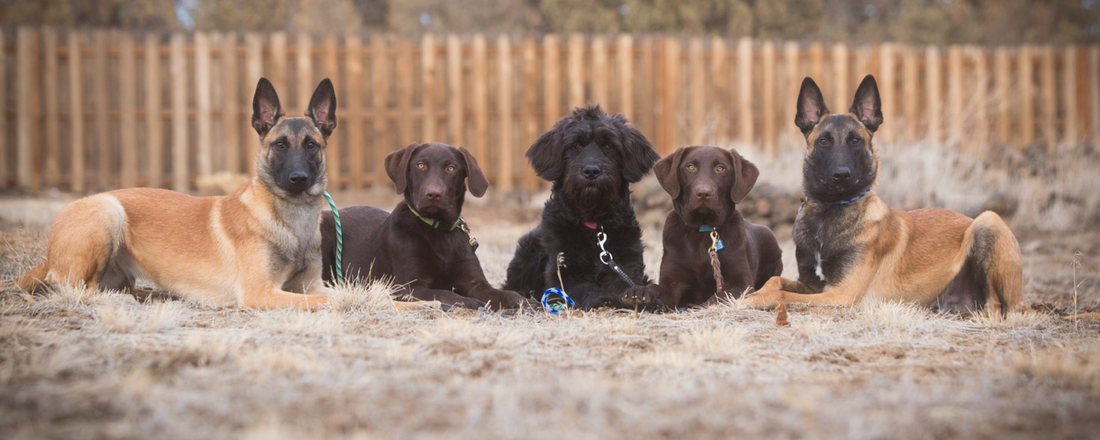 There is a lot of discussion in the dog training world about “pet dogs vs. sport dogs” and the different requirements of training methodology to meet the needs and goals of these dogs in their respective “group”. In conjunction with this conversation, we often hear terms thrown around about training a dog “in drive” vs. “out of drive”. Let us start off by saying, as a business named “The Art of Dogs”, we are (ironically) heavily reliant on science for the basis of all of our work with our client’s dogs as well as our own. So, we will begin by defining what the term “drive” actually refers to in the world of behavior. • Drive (n) : an innate, biologically determined urge to attain a goal or satisfy a need That means that any time you are using food to manipulate your dog’s behavior, you are utilizing and bringing out their drive. Most commonly though, people refer to dogs with large a amount of energy and motivation as “high drive dogs”. These can be anything from your typical Border Collie to field-bred Labrador to working line Shepherd to game-bred bully breed, just to name a few examples. We love high energy, highly motivated and “high drive dogs”! Dogs that fall into this category are our most popular clientele! However, we also love your independent and “unmotivated” pet Poodle, Bulldog and unknown shelter mix because we understand that the well-rounded approach to dog training all stems from the same foundational understanding of clear and consistent communication that involves utilizing motivational methods and fair, calm handling. And the approach that is used for any given dog is determined by the dog’s reaction to his or her environment.  Simply put, dog training involves, at a very basic level: being skilled at utilizing proper timing, consistency and motivation while progressing the duration and distraction level of a given behavior. At The Art of Dogs, we do both sport and pet dog training, and we will bring out the juice in dogs to make them “in drive” as well as make sure we can have a clear and fair understanding of when it’s time to be more calm and “turned off from drive”. “But I don’t want or need my dog to have fancy moves, I just want a well-mannered pet!” Well, think about what that entails. Probably a whole lot of “don’t do this” and “you can’t have that”. A whole lot of “No!”’s and “Stop it already!”. We got into dog sports because we noticed this very thing. And it wasn’t fun—for anyone— to be locked into a metaphorical (or literal) box of a world because there weren’t enough outlets for the dog to release the mental and physical energy and frustrations that have been bred into most dogs for hundreds, if not thousands, of years. So what happens when you get a dog that’s been genetically programmed to be simulated and frustrated by a variety of triggers in our modern world? Those are the dogs most likely to become leash reactive, have separation anxiety, become destructive, unable to settle, and so on, as a result of too much pent up frustration that has no fair release to apply this “drive”. One great correlation between combining pet dog training and sport dog training is to have the ability to interrupt a dog that is in a high state of excitement or arousal. Think about the mindset that your pet dog is in while he or she is at the end of the leash barking like a mad dog at something, and then compare that to a sport dog that is channeling his or her pent up frustrations into a focused behavior in anticipation of earning a toy reward. You will see similar intense focus with those crazy eyes in both of these examples. But one of these examples is a result of us offering release for the frustrated dog, and one is likely a result of a frustrated that does not have anywhere else to channel this energy. One really big side effect that we are seeing as a result of people not understanding the needs of high energy dogs with a strong desire to run, chase, and bite, etc. is a massive boost in breeds such as Belgian Malinois cropping up in shelters all over the country. Malinois are a breed we own and work a lot with and you will see them on our social media pages every now and then, but they are a largely misunderstood breed. They are indeed beautiful and intelligent, which leads many well-intending people towards getting one of these dogs. But they also have incredibly high demands that the vast majority of every day dog owners cannot meet. Their extremely high levels of energy, prey drive, and often lower thresholds for bite inhibition and less social and environmental stability than many other breeds leads these dogs to be a recipe for disaster in the wrong hands, when not appropriately channeled. Understanding the difference of wanting a well-rounded pet/companion dog versus opting for a high drive sport or working breed is critical ground work to have in place before adding any dog to your life, to ensure the best possible chances for life-long partnership and fulfillment for both human and dog. Perhaps you’re still reading this and are stuck on what I meant right from the beginning by “sport dogs”. I am referring to the wonderful world of dog-handler activities such as agility, competitive obedience, frisbee, protection sports, and so much more. If you are interested in learning more about dog sports and/or want to look deeper into this discussion, be sure to continue following our social media pages! We have about a dozen different blogs that are started as well, and we will touch a lot more on this topic and many others soon. And if you are interested in getting hands on experience with high drive dogs, the west coast based Belgian Malinois rescue Woof Project is flooded with dogs right now, and is always looking for volunteers in the form of foster homes, transportation, and many other ways to help. Visit www.woofproject.org for more information. Post by Anneliese
7 Comments
 When you’re as tiny and adorable as Lucy, it can be hard for people to ignore you and keep their hands and squeals to themselves! And while I certainly can’t argue with being tempted to cuddle such a cute puppy, it’s so important that as puppy owners, we are their advocate. And as people in the public, we respect other people’s wishes, and this includes those requests regarding their dog. What do I mean by this? Well, I constantly get calls and emails from owners of young dogs that have developed behavior problems that are caused by this very big issue. Wonderful, well-intentioned dog owners who take their puppy or newly adopted dog out and about, to get them the exposure and socialization that so many puppy raising books and even other pet professionals insist that you do. Again- the intention is solid. And you are a good dog owner. It only makes sense to get them out as much as possible! So why is your puppy or dog developing behaviors such as incessant pulling towards strangers, barking and whining when they see another dog, have this seemingly impossible-to-break jumping habit, and completely ignoring you when anything potentially exciting is going on around? Or maybe your dog isn’t the boisterous, outgoing type and instead, he or she exhibits behaviors such as avoiding people or dogs, whining, maybe even peeing or growling when people get too close. Both of these “types” can often times be rooted in the same style of puppy raising, and signs can’t always be seen early on. The mindset that you must take your puppy out and let them meet most every dog and person that you encounter to socialize them creates the expectation of just that— that they will always get to meet every person or dog that they encounter, and when you decide that they are “socialized enough” and you go to break this habit, it is a change in their routine that frustrates them. And rightfully so, as you are breaking the expectation that you’ve created for them out in the world. Then what’s the solution?? I’m definitely not saying to keep your puppy from meeting new people or dogs, but there are absolutely good and bad ways to go about exposing and socializing your dog. We are here and happy to help you understand this process better, and be as involved to help guide you through this period as much as you’d like. Lucy is a five month old Labradoodle puppy whose parents do private lessons with me, and they are now supplementing her private lesson program with adding some days of our Day Camp services to get her more proper exposure and continue improving her socialization skills. If this sounds like something you are interested in learning more about, I’m always only a call, e-mail, or message away! Post by Anneliese “They will grow out of it.”
The truth is, they won’t grow out of it— but actually, grow into it. Mouthing. Jumping. Barking. Humping. Digging. Pulling… The list goes on. You tell yourself, “Oh, but she’s just a puppy. She’ll grow out of it.” or “He will be neutered soon, and then he will listen better.” These are things that we, as dog trainers, hear all the time. “I was told that this breed calms down at 2 years old, so we still have time.” Having this mindset with your adolescent dog is not fair to them, or to yourself. Puppies are little sponges that are learning and experimenting from day one, and they will continue the behaviors that they rehearse from early on— until they are shown otherwise. And as we all know, practice makes perfect. By giving your young dog a pass on acting up because you feel that he is going to change over time on his own, you are creating unrealistic and unattainable expectations, and in turn, setting him up for failure. Additionally, we should take into account what makes the most sense for your dog. If for months, they are allowed to jump on people, bark at the door or surf the counter tops, at what point do we say that's not okay and suddenly change the rules. The more we change expectations the more confused we make our dog. You got a puppy because you wanted to raise him to be the ideal companion for your lifestyle. A puppy to show the ropes to, to bond and grow with while you explore new adventures together. If this resonates with you and you are looking for guidance with your own young dog, we are here and happy to help! Post by Anneliese |
Archives
August 2019
Categories |
LocationOur training space is located in the town of Carmel, in New York state. We serve the greater NYC / Tri-State Area!
|
|
Copyright - The Art of Dogs


 RSS Feed
RSS Feed